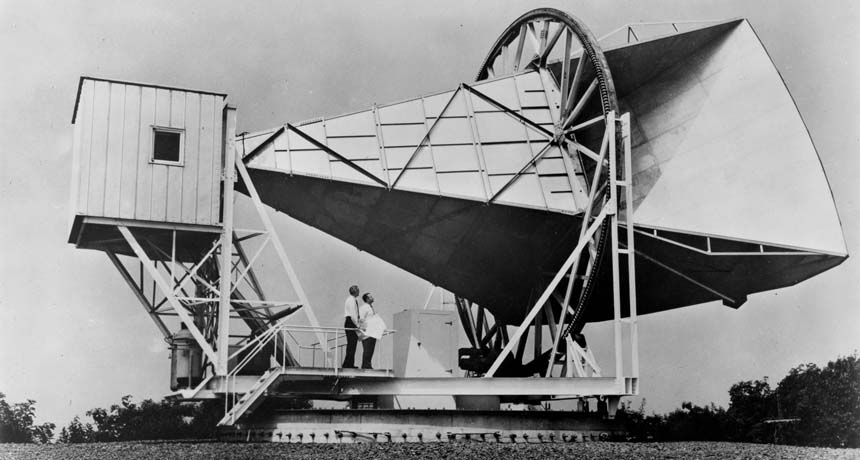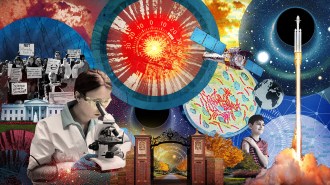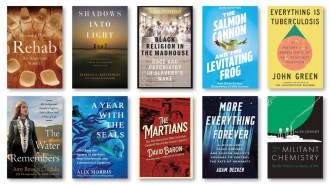Top 10 science anniversaries in 2014

Using the 15-meter Holmdel Horn Antenna in New Jersey, astronomers discovered the cosmic microwave background, a remnant of the Big Bang fireball from the birth of the universe.
NASA
- More than 2 years ago
Scientists, and science writers, are always looking for an excuse to celebrate an anniversary. Bloggers in particular like anniversaries for those rare times when it’s hard to find something current to write about.
For science anniversaries, 2014 was especially rich, providing opportunities for a diverse panoply of posts. And I have seized some of those opportunities, commenting on the 50th anniversary of quarks, for instance, and the 400th anniversary of logarithms.
Sadly, though, 2014 is slipping away. Plenty of anniversaries remain uncelebrated, without enough weeks to accommodate them all. Fortunately blogging has a convenient trick for coping with a time shortage: you can just put them all in one post in the form of a list.
So here are my Top 10 science anniversaries of 2014. They’re not in order of importance — there’s no objective metric for that. We’ll go instead with chronological, most recent first.
10. Quantum factoring algorithm, 1994
Mathematician Peter Shor figured out a way to crack the toughest secret codes available — if anybody could build a quantum computer. Physicists had discussed the possibility of such a computer, which could exploit the weirdness of quantum mechanics to perform calculations to solve some kinds of problems with speeds impossible using an ordinary computer. Nobody got excited about that, though, because nobody knew of any such problems that were actually important for anything. Shor provided the killer quantum computer app, launching vigorous efforts, still in progress today, to make quantum computers real.
9. Cosmic microwave background, 1964
Much of modern cosmology emerged from the detection of a vast bath of microwaves pervading all of space, a dim glowing remnant of the Big Bang fireball from the birth of the universe. Now cooled to less than 3 degrees above absolute zero, that glow retains the imprint of the bits of matter in the baby universe that eventually grew into galaxies. Thus astronomers today can measure properties of the infant cosmos universe to test their theories of cosmic origins. Arno Penzias and Robert Wilson discovered the microwaves in 1964 when they found that no matter what they did, including cleaning the pigeon poop off their radio telescope, they could not eliminate a faint static.
8. Quarks, 1964
Murray Gell-Mann (and independently, George Zweig) figured out theoretically that matter made more sense if protons and neutrons had parts. Many members of the bewildering zoo of subatomic particles discovered in the 1950s and early ’60s turned out to be just simple combinations of quarks. Baryons — protons and neutrons, for example — contained three quarks; mesons contained two (well, one regular quark plus an antiquark). Quarks paved the way for today’s standard model of particle physics, which categorizes all of nature’s particles of matter as either quarks or leptons (such as electrons and neutrinos), along with particles that transmit forces, called bosons.
7. Time symmetry violation, 1964
From Newton’s time, physicists believed that nature did not distinguish past from future — in other words, the laws governing motion operated in just the same way going forward in time or backward. But in 1964, Val Fitch and James Cronin performed an experiment on a rare subatomic particle, the neutral K meson. From the way it decayed, Cronin and Fitch could infer that time in one direction did not precisely match time in the other direction (unless a lot of other well-established facts about nature were somehow wrong). The time direction disparity was more directly confirmed in later years, but it still remains a bit puzzling. In any case, the K meson time asymmetry does not appear to have anything to do with the fact that time seems to always flow forward in the messy world of real life.
6. Atomic number, 1914
Working at the University of Manchester under the direction of Ernest Rutherford, Henry G. J. Moseley was in the thick of new experimental findings on the nature of the atom, including the discovery of its nucleus, reported by Rutherford in 1911. Moseley himself studied the x-ray radiation given off by different elements, which led to his realization that there was a new way to identify and order them. Others working at Manchester at the time had realized that such an “atomic number” would give the elements their proper position in Mendeleyev’s periodic table. But it was Moseley who conducted the x-ray experiments that established the correct number for each known element and identified the gaps —numbers for which no element had yet been discovered — at numbers 43, 61 and 75. A few months after his work was published, World War I began, Moseley joined the army, and in 1915 he took a bullet in the brain, dying at the age of 27.
5. Pasteurization, 1864
After many years investigating the science behind fermentation, Louis Pasteur became something of a wine connoisseur. He realized that bacteria played a role when wine went bad, so in 1864 he devised his famous heating strategy to eliminate many of the bacteria without total sterilization, which would have ruined the wine’s flavor and color. Earlier researchers had performed similar experiments, but Pasteur was savvy enough to patent the process the next year.
4. Solar spectral lines, 1814
Joseph von Fraunhofer was a glassmaker who developed methods for producing very high quality optical lenses and prisms. His interest in phenomena like refraction led him to analyze colors of light across the visible spectrum, developing a device to measure wavelengths precisely. When using his device to analyze light from the sun, he found hundreds of dark lines at specific wavelengths. (Light was missing at those colors because those wavelengths were absorbed by intervening matter.) A few such dark lines had been seen earlier by William Wollaston but he didn’t pay any attention to them. Fraunhofer measured the lines much more precisely. His 1814 discovery marked the birth of modern spectroscopy, later developed into a method for identifying substances by the pattern of colors they absorbed or emitted. Spectroscopes became widely used in many realms of science, particularly astronomy, where they enabled observers to study the chemical composition of stars and other matter in the cosmos, rendering erroneous the claim that earthbound astronomers would never know what the stars are made of.
3. Mercury thermometer, 1714
Daniel Gabriel Fahrenheit was a scientific instrument maker who traveled around Europe to the best labs to learn techniques for making various measuring devices. His travels included a visit to Olaus Rømer, a Danish astronomer who had constructed thermometers that used wine. Fahrenheit developed an improved alcohol-based thermometer but made a much bigger advance with his invention of a mercury-based thermometer in 1714. Only later did Fahrenheit devise his famous temperature scale, based on a scale developed by Rømer but differing in key ways because Fahrenheit was confused by Rømer’s notion of the temperature of blood.
A key aid to calculating for astronomical and other problems, logarithms became a valuable mathematical tool for all sorts of science and insights into natural processes. John Napier’s version, published in 1614, was soon amended by Henry Briggs into something close to their current form. Logarithms also provided the basis for slide rules, which will deserve an anniversary celebration of their own someday.
1. Birth of Vesalius, 1514
Andreas Vesalius was born in Brussels but his mother was English. He studied medicine (a family tradition) and eventually became a military surgeon, which may have played a role in the taste he developed for dissecting things. He became famous as an anatomist, producing the first book on human anatomy that valued accuracy over adherence to inaccurate ancient beliefs. Vesalius was better at bodily structure than function, although he did understand that mental function occurred in the brain, not in the heart, as some of the ancient Greeks had believed.
Follow me on Twitter: @tom_siegfried







